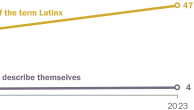This study reports on an alternative estimate of the breakdown of the Hispanic population according to national origin groups. Based on recently released Census Bureau data, the estimate reduces the “other” category by more than half. This estimate does not change the overall size of the Hispanic population, but it does offer a new calculation of how national groups are distributed within that population.
Among the key findings using these new estimates:
• The number of Dominicans may have actually increased by some 80 percent between 1990 and 2000 to more than 938,000 nationwide. The Census 2000 count of 764,495 Dominicans yielded an increase of only 47 percent over 1990. In the New York City metropolitan area the Dominican population may be 25 percent larger than the count in Census 2000. • The population with origins in El Salvador apparently increased by 65 percent nationally to more than 932,000, compared to a Census 2000 count of 655,155, which would have marked an increase of only 16 percent. The Salvadoran population in the Los Angeles metropolitan area is some 60 percent larger in the alternative estimate than the Census 2000 figure. • The alternative estimates indicate that Mexican population may have grown by 60 percent nationwide to more than 22 million rather than the Census 2000 count of 20.6 million, which produced a growth rate of 54 percent since 1990. • In Florida, where the Latino population is increasingly diverse, the Central American population is nearly 55 percent larger in the alternative estimate than the Census 2000 figure and the South American population is 37 percent larger.




